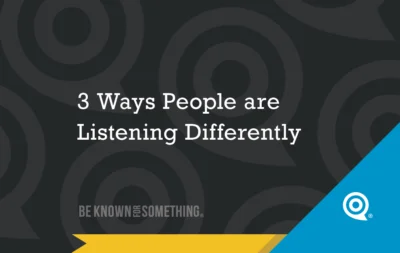
Yikes, People are Listening Differently (3 ways)
I remember years ago, on a summer vacation, my parents stopped near a lake to take a break from driving
Note: it was brought to my attention that Commandment 6 was left out of the blog about Church Websites. Sorry. Here it is!
Recently, I picked up a book I wanted to read.
Really! I wanted to read it because I had read an article that shared some highlights from its chapters and it interested me.
I settled into my comfortable “reading” chair and cracked the book cover. There’s something to be said for the anticipation that comes from that sound. I flipped passed all those useless, extra pages that say who wrote it. I stopped when I saw the header, “Chapter One”, and then started to read.
Some books just suck me in. The story. The characters. The information. This one had all that, but I kept having to re-read lines and I felt like I was struggling to keep moving into the book.
What was the problem?
After I realized the energy that I was expending in order to get the information, I stopped to look at the layout of the pages. The font was ok, however, a bit small, and the lines were pretty tight together. But the lines were too long!
Throughout most of printing history, books start with galleys (columns of text) pasted onto the layout board in columns. These lines were easy to read because there weren’t very many words on each line, and you could easily navigate back to the next line.
A newspaper does this extraordinary well. They have to get a lot of information out and not confuse the reader. That’s what a good grid can do.
But there’s more than a good grid can do! The grid can help you make decisions. Where graphics start and stop. How big a photo should be. Where your menu will be aligned. Even how many buttons to use.
At Be Known for Something we try to keep lines of copy fairly short. About 600 pixels wide. Or try to have 8-12 words maximum per line. Never less than 3 words per column.
Then we want to allow enough space around the text to provide an organized, well-designed layout.
It’s a bit hard to describe when it comes to these brief blogs, but we go through a 3-step process:
Well, there you have it! Now, you use the grid to align material by using multiples of the grid width to determine size and length.
Allow space at the top for brand and menus, and a column on the left for secondary menus or information. The far right column can be reserved for ads or very tertiary information. Remember, that most people look to the center column for their needs.
There are diagrams illustrating this (perhaps better than words did) in the FREE book “10 Commandments of Church Websites” that we put together. Just go to the web page and register for it and I’ll send it to you.
And as usual, I’ll answer any questions you have here. Just click on comments!

I remember years ago, on a summer vacation, my parents stopped near a lake to take a break from driving

Everyone likes to be found: that’s why Church SEO is important. Especially being found on Google (or Yahoo, Bing, etc.)

When I’ve taught Sunday School classes, I’m always amazed how attendance fluctuated very little each week yet we had different
Discover your thread®. Be Known for Something® relevant and needed. Pastor, control your church brand and be heard again.
– Discover Your Audience
– Build Your Brand
– Communicate & Be Heard
Communicate so your congregation & community pays attention to your website, social media, & email!
We'll never spam you. Unsubscribe anytime.
